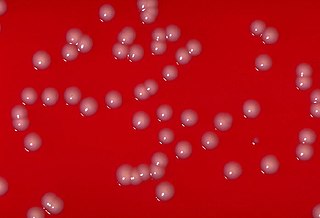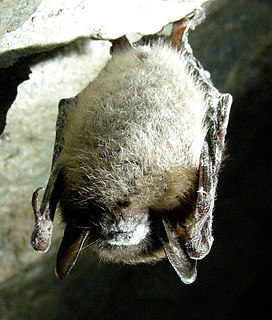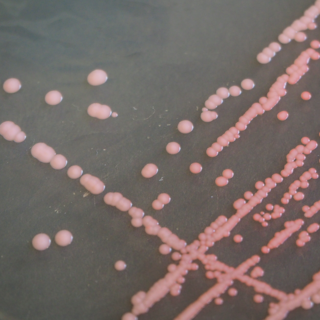Related Research Articles

Corynebacterium is a genus of bacteria that are Gram-positive and aerobic. They are bacilli (rod-shaped), and in some phases of life they are, more particularly, club-shaped, which inspired the genus name.
Galactosidases are enzymes that catalyze the hydrolysis of galactosides into monosaccharides.
Mycobacterium agri is a species of the phylum Actinobacteria, belonging to the genus Mycobacterium.
Mycobacterium brisbanense is a member of the Mycobacterium fortuitum third biovariant complex. They are rapidly growing ubiquitous environmental organisms that normally inhabit soil, dust and water. These organisms frequently are human pathogens that cause a wide spectrum of clinically significant disease. It is important for practitioners to be aware of these organisms as possible etiological agents, as they are resistant to most first-line anti-tuberculous agents.
Mycobacterium hiberniae is a species of the phylum Actinobacteria, belonging to the genus Mycobacterium.

A cutinase (EC 3.1.1.74) is an enzyme that catalyzes the chemical reaction
Cronobacter is a genus of Gram-negative, facultatively anaerobic, oxidase-negative, catalase-positive, rod-shaped bacteria of the family Enterobacteriaceae. They are generally motile, reduce nitrate, use citrate, hydrolyze esculin and arginine, and are positive for L-ornithine decarboxylation. Acid is produced from D-glucose, D-sucrose, D-raffinose, D-melibiose, D-cellobiose, D-mannitol, D-mannose, L-rhamnose, L-arabinose, D-trehalose, galacturonate and D-maltose. Cronobacter spp. are also generally positive for acetoin production and negative for the methyl red test, indicating 2,3-butanediol rather than mixed acid fermentation. The type species of the genus Cronobacter is Cronobacter sakazakii comb. nov.

A lipase is any enzyme that catalyzes the hydrolysis of fats (lipids). Lipases are a subclass of the esterases.
Macrococcus is a genus of Gram-positive cocci belonging to the family Staphylococcaceae. The genus was created in 1998.
Staphylococcus nepalensis is a Gram-positive coccoid bacterium belonging to the genus Staphylococcus.
Staphylococcus succinus is a Gram-positive coccoid bacterium belonging to the genus Staphylococcus.
Staphylococcus muscae is a Gram-positive coccoid bacterium belonging to the genus Staphylococcus.

Pseudogymnoascus destructans is a psychrophilic (cold-loving) fungus that causes white-nose syndrome (WNS), a fatal disease that has devastated bat populations in parts of the United States and Canada. Unlike species of Geomyces, P. destructans forms asymmetrically curved conidia. Pseudogymnoascus destructans grows very slowly on artificial media and cannot grow at temperatures above 20 °C. It can grow around 4 °C to 20 °C, which encompasses the temperatures found in winter bat hibernacula. Phylogenic evaluation has revealed this organism should be reclassified under the family Pseudeurotiaceae, changing its name to Pseudogymnoascus destructans.
Paenibacillus tylopili is a soil-dwelling, Gram-positive, rod-shaped bacterium. Described as new to science in 2008, it was found in the mycorhizosphere of the bolete fungus Tylopilus felleus.
Parasutterella is a genus of Gram-negative, circular/rod-shaped, obligate anaerobic, non-spore forming bacteria from the Proteobacteria phylum, Betaproteobacteria class and the family Sutterellaceae. Previously, this genus was considered "unculturable," meaning that it could not be characterized through conventional laboratory techniques, such as grow in culture due its unique requirements of anaerobic environment. The genus was initially discovered through 16S rRNA sequencing and bioinformatics analysis. By analyzing the sequence similarity, Parasutterella was determined to be related most closely to the genus Sutterella and previously classified in the family Alcaligenaceae.
Macrococcus lamae is a species of bacteria belonging to the genus Macrococcus. Strains of this species were originally isolated from the skin of llamas.
Haloferax larsenii is a gram-negative, aerobic, neutrophilic, extremely halophilic archaeon. It was named in honor of Professor Helge Larsen, who pioneered research on halophiles.
Macrococcus hajekii is a species of bacteria belonging to the genus Macrococcus. Strains of this species were originally isolated from the skin of llamas.
Flavobacterium psychrophilum is a psychrophilic, gram-negative bacterial rod, belonging to the Bacteriodetes. It is the causative agent of bacterial coldwater disease (CWD) and was first isolated in 1948 during a die-off in the salmonid Oncorhychus kisutch.

Arthrobacter bussei is a pink-coloured, aerobic, coccus-shaped, Gram-stain-positive, oxidase-positive and catalase-positive bacterium isolated from cheese made of cow´s milk. A. bussei is non-motile and does not form spores. Rod–coccus life cycle is not observed. Cells are 1.1–1.5 µm in diameter. On trypticase soy agar it forms pink-coloured, raised and round colonies, which are 1.0 mm in diameter after 5 days at 30 °C The genome of the strain A. bussei KR32T has been fully sequenced.
References
- 1 2 Mannerová, S; Pantůcek, R; Doskar, J; Svec, P; Snauwaert, C; Vancanneyt, M; Swings, J; Sedlácek, I (2003). "Macrococcus brunensis sp. Nov., Macrococcus hajekii sp. Nov. And Macrococcus lamae sp. Nov., from the skin of llamas". International Journal of Systematic and Evolutionary Microbiology. 53 (Pt 5): 1647–54. doi: 10.1099/ijs.0.02683-0 . PMID 13130064.